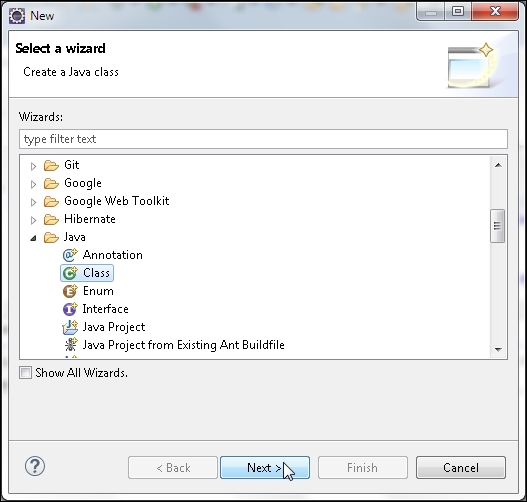In this section, we will create an EJB 3.0 entity bean for a domain model. Create the org.jboss.springmvc.model.Catalog entity bean class, which is just a plain old Java object (POJO). To create a Java class, select File | New | Other, and in New, select Java | Class, as shown in the following screenshot:

In the New Java Class wizard, select Source folder as jboss-springmvc/src/main/java, specify Package as org.jboss.springmvc.model, and specify the class Name as Catalog, as shown in the following screenshot:

The org.jboss.springmvc.model.Catalog.java class gets added to the project, as shown in Project Explorer in the following screenshot:

Remove the Member.java class and the other Member* classes from the project to get the directory structure, as shown in the following screenshot:

Annotate the Catalog entity class with the @Entity annotation and the @Table annotation. In the @Table annotation, specify the table name as CATALOG and uniqueConstraints using the @UniqueConstraint annotation for the ID column. Specify the no-argument constructor, which is required in an entity class. The entity class implements the Serializable interface to serialize a cache-enabled entity bean to a cache when persisted to a database. To associate a version number with a serializable class by serialization runtime, specify a serialVersionUID variable. Declare variables for the bean properties: id, journal, publisher, edition, title, and author. Add getter/setter methods for the bean properties. The @Id annotation specifies the identifier property. The @Column annotation specifies the column name associated with the property. The nullable element is set to false as the primary key cannot be null.
If we were using the Oracle database, we would have specified the primary key generator to be of the type sequence using the @SequenceGenerator annotation. The generation strategy is specified with the @GeneratedValue annotation. For the Oracle database, the generation strategy would be strategy=GenerationType.SEQUENCE, but because MySQL database supports auto-increment of primary key column values by generating a sequence, we have set the generation strategy to GenerationType.AUTO. The Catalog.java entity class is listed in the following code snippet:
package org.jboss.springmvc.model;
import java.io.Serializable;
import javax.persistence.*;
/**
* The persistent class for the CATALOG database table.
*
*/
@Entity
@Table(name = "CATALOG", uniqueConstraints = @UniqueConstraint(columnNames = "ID"))
public class Catalog implements Serializable {
private static final long serialVersionUID = 1L;
private int id;
private String journal;
private String publisher;
private String edition;
private String title;
private String author;
public Catalog() {
}
@Id
@Column(name = "ID", nullable = false)
@GeneratedValue(strategy = GenerationType.AUTO)
public int getId() {
return this.id;
}
public void setId(int id) {
this.id = id;
}
public String getJournal() {
return this.journal;
}
public void setJournal(String journal) {
this.journal = journal;
}
public String getPublisher() {
return this.publisher;
}
public void setPublisher(String publisher) {
this.publisher = publisher;
}
public String getEdition() {
return this.edition;
}
public void setEdition(String edition) {
this.edition = edition;
}
public String getTitle() {
return this.title;
}
public void setTitle(String title) {
this.title = title;
}
public String getAuthor() {
return this.author;
}
public void setAuthor(String author) {
this.author = author;
}
}